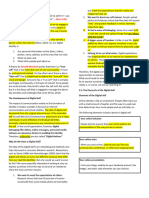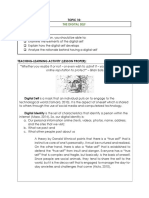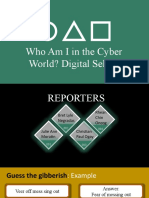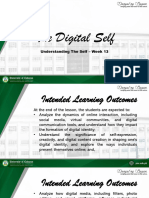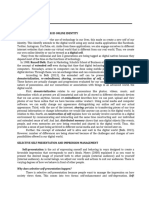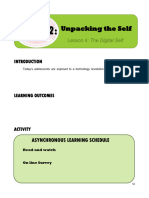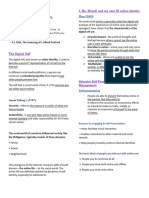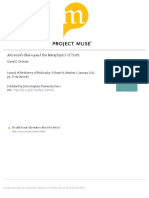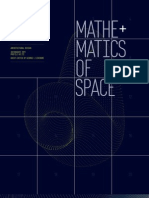0 ratings0% found this document useful (0 votes)
6 viewsSemifinals - UTS
Semifinals - UTS
Uploaded by
cassandra.delacruz88Copyright:
© All Rights Reserved
Available Formats
Download as DOCX, PDF, TXT or read online from Scribd
Semifinals - UTS
Semifinals - UTS
Uploaded by
cassandra.delacruz880 ratings0% found this document useful (0 votes)
6 views2 pagesOriginal Title
Semifinals- UTS
Copyright
© © All Rights Reserved
Available Formats
DOCX, PDF, TXT or read online from Scribd
Share this document
Did you find this document useful?
Is this content inappropriate?
Copyright:
© All Rights Reserved
Available Formats
Download as DOCX, PDF, TXT or read online from Scribd
Download as docx, pdf, or txt
0 ratings0% found this document useful (0 votes)
6 views2 pagesSemifinals - UTS
Semifinals - UTS
Uploaded by
cassandra.delacruz88Copyright:
© All Rights Reserved
Available Formats
Download as DOCX, PDF, TXT or read online from Scribd
Download as docx, pdf, or txt
You are on page 1of 2
Digital Self between online and offline identities, while
augmented reality suggests these identities are
The concept of the "Digital Self" explores how we intertwined and enhance each other.
construct and present our identities online. This
involves forming a digital persona, influenced by Extended Mind in the Digital Age- Andy Clark
social media interactions, anonymity, and personal and David Chalmers have contributed to the theory
expression choices. Online behavior differs from of the extended mind. This theory argues that digital
offline, often due to factors like disinhibition, which tools and technologies extend human cognition,
can lead to either positive or negative expressions. allowing individuals to store, process, and
Gender, social expectations, and privacy boundaries communicate information more effectively.
also play significant roles.
Augmented Reality Theory- Authors like Milgram
Online Identity and Persona and Kishino have discussed the layers of reality in
the context of augmented reality. This framework
Online Identity examines how digital overlays enhance perceptions of
Allows for experimentation with different reality, impacting how identities are experienced and
personas. expressed in both virtual and physical spaces.
Provides control over self-presentation and
selective sharing. ELEMENTS OF DIGITAL SELF
Encourages engagement with diverse
communities and expression beyond physical 1. Social Media Profiles: Platforms like Facebook,
constraints. Instagram, Twitter, and LinkedIn help shape our
digital identities through profiles and interactions.
offline Identity 2. Online Communication: Emails and messaging
Shaped by physical appearance, location, apps influence how we express ourselves and connect
social roles. with others online.
Influenced by cultural norms and real-time 3. Digital Footprint: The data trail from our online
feedback from others. activities, such as browsing history and purchases,
Social interactions may limit self-expression. affects how others perceive us.
4. User-Generated Content: Content like blogs,
ROLE OF ANONYMITY videos, and photos showcases our interests, skills,
Online spaces create an environment of anonymity and experiences, contributing to our online persona.
that fosters greater freedom for self-exploration, 5. Virtual Avatars: In games and virtual worlds,
allowing individuals to experiment with different people use avatars to show their personality and
aspects of their identities without the immediate creativity.
judgment that often accompanies offline interactions. 6. Online Communities: Forums and groups help
shape beliefs and values, impacting one’s online
Disinhibition identity.
This is also referred to as behavioral disinhibition, is 7. Professional Profiles: LinkedIn acts as a digital
recognized as the orientation towards immediate resume, highlighting skills, achievements, and
gratification, leading to impulsive behavior driven by professional connections.
current thoughts, feelings, and external stimuli. 8. Digital Skills: Comfort with technology and online
tools is a key part of the digital self.
Types of DISINHIBITIONS 9. Privacy Settings: Choices about privacy on social
Benign- refers to the positive effects of anonymity media control how much of one’s digital self is visible
online, where individuals feel free to express to others.
thoughts, share personal experiences, and connect 10. Online Reputation: Reviews, ratings, and
with others empathetically. This can foster supportive feedback shape how others view an individual’s
communities and open dialogues. online identity.
Toxic- on the other hand, involves negative behaviors
that arise from the same anonymity. People may Characteristics of Digital Self
engage in harmful, aggressive, or disrespectful
communication, often without fear of repercussions. Dynamic Identity: The digital self-changes over
time with new experiences and technologies.
Theories of Digital Self Multifaceted: It includes different parts of our
identity—personal, professional, social, and cultural.
Digital Identity Construction- This theory of Selective Sharing: People choose what to show
Judith Donath and Sherry Turkle explores how online based on the audience.
individuals create and manage their identities through Digital Literacy: Knowing how to navigate and
online platforms, emphasizing the fluidity and behave online is essential.
adaptability of self-presentation. Lasting Impact: Online actions can leave a
permanent record.
Digital Dualism vs. augmented reality- Nathan Virtual Presence: The digital self exists beyond the
Jurgenson is known for discussing the concept of physical world, in online communities and virtual
digital dualism. Digital dualism posits a separation spaces.
Interconnectedness: The digital self is influenced For example, your physical health is very important,
by social networks and online trends. you shouldn't just ignore any symptoms you might
Privacy Concerns: People balance sharing with experience. Instead, you should see a doctor
privacy and data security worries. immediately. That means being a responsible person
Digital Expression: Online, individuals express that takes charge of his or her health.
themselves through text, images, videos, and more.
Digital Citizenship: Being responsible and ethical STEPS TO PRACTICE OF RESPONSIBILITY
online shapes positive interactions and communities. 1. Self-awareness
2. Take full ownership of your actions
Principles of Digital Self 3. Zoom in and zoom out
1. Authenticity: Be true to yourself online; show your 4. Stick to your plan
real values and identity. 5. Keep growing and keep smiling
2. Intentionality: Think about the purpose and impact
of what you share. Here are the key concepts for a report on
3. Digital Literacy: Develop skills to navigate, Responsible self:
evaluate, and understand digital spaces. Accountability
4. Privacy and Security: Protect your personal info and Decision-making
manage privacy settings. Emotional Regulation
5. Empathy and Respect: Treat others with kindness, Reflection
understand different views, and avoid harmful Personal Growth
behaviors. Consequences of Irresponsibility
6. Balance and Wellbeing: Keep a healthy balance
between online and offline life to support mental and Benefits of Responsible Self in connection to
emotional health. our role in the hospital:
7. Digital Citizenship: Act responsibly online, respect - Enhanced Patient Care’
platform rules, and contribute positively. - Professional Accountability
8. Curatorial Mindset: Be thoughtful about what you - Improved Decision-Making Skills
share, considering your audience. - Effective Communication
9. Continual Learning: Keep up with new digital - Increased Resilience
trends, tech, and skills. - Stronger Professional Relationships
10. Critical Thinking: Question sources, fact-check, - Personal and Professional Growth
and think carefully about the content you engage with - Ethical Practice
and share. - Confidence Building
- Preparation for Future Roles
RESPONSIBLE SELF CONCLUSION
- it means holding yourself accountable for your In conclusion, cultivating a responsible self is
words and actions instead of blaming others or fundamental to achieving personal and interpersonal
making constant excuses it means taking success. By embracing accountability for our actions
responsibility for your own successes but most and decisions, we not only foster personal growth and
importantly for your own failures. resilience but also enhance our relationships with
others. The benefits of self-responsibility extend
Personal Responsibility beyond individual well-being; they create a positive
Accountability ripple effect that can inspire and uplift those around
Self-discipline us. As we strive to take ownership of our lives, we
Time Managment unlock our potential for meaningful change and
Integrity fulfillment. Ultimately, adopting a responsible mindset
Reliability empowers us to navigate challenges with confidence
Self-Care and purpose, leading to a more rewarding and
Adaptability impactful life.
Most common characteristics of avoiding self-
responsibility:
1. Blaming others
2. Self-serving bias
3. Low self-control
According to Marcko (2023), Being responsible means
taking full responsibility for one’s action. This doesn't
mean that you have to accept everything that
happens to you. However, if something goes wrong,
you should try to find a solution rather than making
excuses.
You might also like
- Spahlinger This Is The Time of Conceptive Ideologues No Longer PDFDocument17 pagesSpahlinger This Is The Time of Conceptive Ideologues No Longer PDFAcacioNo ratings yet
- Esoteric Meaning of 1st Degree Masonic Tracing BoardDocument54 pagesEsoteric Meaning of 1st Degree Masonic Tracing BoardGabriel Comia, Jr.91% (11)
- Alan Moore - Magic Running in The Gutters Like LightningDocument9 pagesAlan Moore - Magic Running in The Gutters Like Lightninglbds100% (1)
- UTS-Reporting - 20240407 164909 0000Document27 pagesUTS-Reporting - 20240407 164909 0000Mary jane HamtigNo ratings yet
- Psych M9 Digital SlefDocument3 pagesPsych M9 Digital SlefMiss MaNo ratings yet
- Microsoft Word - PSYCH100-8Document5 pagesMicrosoft Word - PSYCH100-8Ink BalgNo ratings yet
- Digital 114219Document18 pagesDigital 114219cresline repollo cuyosNo ratings yet
- Chapter 9 Digital SelfDocument6 pagesChapter 9 Digital SelfBONIFACIO, SHARMAINE G.No ratings yet
- Ge1-Module 11-Digital SelfDocument23 pagesGe1-Module 11-Digital SelfCherry Mae Cabuang100% (1)
- Digital SelfDocument23 pagesDigital SelfMavel Lobitaña100% (1)
- Dgital Self UTS Group 7Document12 pagesDgital Self UTS Group 7bonifaciobunagan26No ratings yet
- ScSc 11n Lesson 2.6 Summary the Digital SelfDocument4 pagesScSc 11n Lesson 2.6 Summary the Digital Selfjosephcoquia16No ratings yet
- Uts Module 3 The Digital SelfDocument4 pagesUts Module 3 The Digital SelfTinay Ledesma GepetacioNo ratings yet
- Ust Exam ReviewerDocument2 pagesUst Exam ReviewerAquino Leah AnnNo ratings yet
- UTS-_-NOTES-reviewerDocument6 pagesUTS-_-NOTES-reviewerlindsaymerizzeNo ratings yet
- Topic RundownsDocument5 pagesTopic RundownsNam LiNo ratings yet
- UTS Final ExaminationDocument10 pagesUTS Final ExaminationMerlyn AytonaNo ratings yet
- MODULE 9 THE DIGITAL SELF (Week 9)Document3 pagesMODULE 9 THE DIGITAL SELF (Week 9)ML CreationsNo ratings yet
- Learning Objectives: Understanding The Self Module 1 - The Digital Self: Self and Other in CyberspaceDocument6 pagesLearning Objectives: Understanding The Self Module 1 - The Digital Self: Self and Other in CyberspaceCherry BobierNo ratings yet
- Who Am I in The Cyber World. Digital SelfDocument24 pagesWho Am I in The Cyber World. Digital SelfAlessandra ArutaNo ratings yet
- Group 6 The Digital SelfDocument14 pagesGroup 6 The Digital SelfRyan Philippe RelovaNo ratings yet
- The Digital SelfDocument16 pagesThe Digital Self2023106826No ratings yet
- Chapter 7 The Digital Self e ModuleDocument8 pagesChapter 7 The Digital Self e ModuleAl Francis DocilNo ratings yet
- Understanding The SelfDocument5 pagesUnderstanding The SelfJuan PauloNo ratings yet
- Unds FinalsDocument8 pagesUnds FinalsBam InNo ratings yet
- Uts Module 7Document5 pagesUts Module 7Dela Rama Virgilio Stephen100% (1)
- Finals Reviewer in Understanding The SelfDocument7 pagesFinals Reviewer in Understanding The SelfBelle TacuyanNo ratings yet
- Digital SelfDocument9 pagesDigital SelfFRANC MELAN TANAY LANDONGNo ratings yet
- Collaborative Computing and Social NetworkingDocument10 pagesCollaborative Computing and Social NetworkingMISSINGGUY GAMINGNo ratings yet
- Psy100-Lesson1-Fn-W13 (20231125074118)Document34 pagesPsy100-Lesson1-Fn-W13 (20231125074118)Jared FradejasNo ratings yet
- Week-13-The-Digital-Self (20241115092209)Document34 pagesWeek-13-The-Digital-Self (20241115092209)rica angelesNo ratings yet
- Unit 2 Chapter 5Document5 pagesUnit 2 Chapter 5kassandrabaquilod5No ratings yet
- Digital Self Setting Goals Stress Management - 054809Document13 pagesDigital Self Setting Goals Stress Management - 054809reyesahronjanierNo ratings yet
- Digital SelfDocument2 pagesDigital Selfjojocircus1995No ratings yet
- Chapter Ii: Unpacking The Self A. The Digital Self: Study Guide For Module No. - 11Document5 pagesChapter Ii: Unpacking The Self A. The Digital Self: Study Guide For Module No. - 11klare montelNo ratings yet
- GE 1 Understanding The Self MODULE 11Document5 pagesGE 1 Understanding The Self MODULE 11klare montelNo ratings yet
- Chapter 6 The Digital SelfDocument11 pagesChapter 6 The Digital SelfCHEEDEL MAE SUNGANo ratings yet
- Lesson 11 - UTSDocument7 pagesLesson 11 - UTSrias gremoryNo ratings yet
- A2Document3 pagesA2Elijah MontefalcoNo ratings yet
- Lecture 9 Digital SelfDocument19 pagesLecture 9 Digital Self[NTC-Student] Vince Roi FanoyNo ratings yet
- The Digital SelfDocument24 pagesThe Digital SelfAriana Faye CastillanoNo ratings yet
- UTS 3Document4 pagesUTS 3aljonvalerozo1995No ratings yet
- Digital Self by Group 1Document17 pagesDigital Self by Group 1clyntonjohn2005No ratings yet
- Understanding The Self Module 13Document5 pagesUnderstanding The Self Module 13Vanessa UbaNo ratings yet
- Digital SELFDocument13 pagesDigital SELFOswaldNo ratings yet
- Chapter 2 Lesson 6 The Self in The Digital and Virtual WorldDocument22 pagesChapter 2 Lesson 6 The Self in The Digital and Virtual WorldYan-Yan BaladecNo ratings yet
- Module 10Document16 pagesModule 10April Tami-ingNo ratings yet
- 9.the Digital SelfDocument25 pages9.the Digital SelfAldrin Hardy PabloNo ratings yet
- Unit 3 - Elec1 ModuleDocument5 pagesUnit 3 - Elec1 ModuleJoana marie TolentinoNo ratings yet
- A1.+Digital+Citizenship+Principles T2 G8 G9Document8 pagesA1.+Digital+Citizenship+Principles T2 G8 G9Kajal PathareNo ratings yet
- UTS Module 2 Lesson 4Document7 pagesUTS Module 2 Lesson 4Fyrshon DagunanNo ratings yet
- Digital SelfDocument21 pagesDigital SelfRodriguez, Divine Faith S.No ratings yet
- W13 Reviewer The Digital SelfDocument5 pagesW13 Reviewer The Digital SelfKenNo ratings yet
- Introduction To Acceptable Behaviour in CyberspaceDocument10 pagesIntroduction To Acceptable Behaviour in Cyberspacevishshivam98105No ratings yet
- Chapter 6 - The Digital Self UTSDocument9 pagesChapter 6 - The Digital Self UTSYlaza PeriaNo ratings yet
- The Socio Digital Self 111Document11 pagesThe Socio Digital Self 111KleiNo ratings yet
- 5.2.2. The Socio-Digital Self - GEC 001-CE12S11 - Understanding The SelfDocument5 pages5.2.2. The Socio-Digital Self - GEC 001-CE12S11 - Understanding The SelfLucky Win CruzNo ratings yet
- Digital SelfDocument7 pagesDigital SelfVhalen ThenoNo ratings yet
- UtsDocument5 pagesUtsDen Angelica DungoNo ratings yet
- Digital and Media Literacy ReviewerDocument6 pagesDigital and Media Literacy ReviewerKaira RazonNo ratings yet
- SAGARDocument6 pagesSAGARak47solankichaudharyNo ratings yet
- Unit 5: The Digital SelfDocument5 pagesUnit 5: The Digital SelfFour NinesNo ratings yet
- The Digital Mind: Understanding the Impact of Social Media on Mental HealthFrom EverandThe Digital Mind: Understanding the Impact of Social Media on Mental HealthNo ratings yet
- Plato Stanford Edu Entries MarcelDocument13 pagesPlato Stanford Edu Entries Marcel23103408No ratings yet
- Steinberg, Diane - On SpinozaDocument100 pagesSteinberg, Diane - On SpinozaavitairyNo ratings yet
- Schutz - Concept and Theory Formation in The Social SciencesDocument17 pagesSchutz - Concept and Theory Formation in The Social SciencesmehmetmsahinNo ratings yet
- Epstein Liquid ImagesDocument14 pagesEpstein Liquid ImagesBernard DionysiusNo ratings yet
- Hse PDFDocument108 pagesHse PDFAnonymous SXVyKIaNo ratings yet
- Notes On Jurisprudence LawDocument147 pagesNotes On Jurisprudence LawGodfrey G. Tesha100% (1)
- Narrative Modes in Acousmatic MusicDocument13 pagesNarrative Modes in Acousmatic MusicLuisNo ratings yet
- 3b Soc Sci 2 MidtermDocument43 pages3b Soc Sci 2 MidtermTrestan TenegraNo ratings yet
- Professor Paul Iles P.iles@leedsmet - Ac.uk: Implementing Strategic Change People & ChangeDocument51 pagesProfessor Paul Iles P.iles@leedsmet - Ac.uk: Implementing Strategic Change People & ChangeallmickeyNo ratings yet
- Postgraduate Research Department: Guideline For Writing A Research ReportDocument68 pagesPostgraduate Research Department: Guideline For Writing A Research ReportMakungu ShirindaNo ratings yet
- La Curación en AvicenaDocument29 pagesLa Curación en Avicenajhon jairo ortegaNo ratings yet
- Chapter 4 Leadership Neuroscience Teboul Insead Paris PDF Free Download Odile JacobDocument16 pagesChapter 4 Leadership Neuroscience Teboul Insead Paris PDF Free Download Odile Jacobjames teboulNo ratings yet
- RMA Interview With Manuel DeLandaDocument8 pagesRMA Interview With Manuel DeLandaandresgviNo ratings yet
- Tok GlossaryDocument14 pagesTok GlossarySahire ArslanNo ratings yet
- The Model MillionaireDocument5 pagesThe Model Millionairezaarafrn100% (1)
- (Great Medieval Thinkers) Stephen Edmund Lahey - John Wyclif-Oxford University Press, USA (2008) PDFDocument305 pages(Great Medieval Thinkers) Stephen Edmund Lahey - John Wyclif-Oxford University Press, USA (2008) PDFMihailoStojanovicNo ratings yet
- (S. - R. - Bhatt, - Anu - Mehrotra, - The - Dalai - Lama) Buddhist Epistemology PDFDocument146 pages(S. - R. - Bhatt, - Anu - Mehrotra, - The - Dalai - Lama) Buddhist Epistemology PDF张晓亮No ratings yet
- 24 28 Basic Concepts of LinguoculturologyDocument5 pages24 28 Basic Concepts of LinguoculturologyDilrabo TursunovaNo ratings yet
- Architectural Design - Mathematics of Space - July / August 2011Document140 pagesArchitectural Design - Mathematics of Space - July / August 2011Kristian BodnarNo ratings yet
- Download Complete Low Pressure Boilers 5th PDF for All ChaptersDocument24 pagesDownload Complete Low Pressure Boilers 5th PDF for All Chaptersthonertiton2675% (4)
- basharvoicesinheadDocument8 pagesbasharvoicesinheadhawkingsdouglasNo ratings yet
- Literature Review TruthDocument5 pagesLiterature Review Truthapi-280520770No ratings yet
- Postmodern Picture of Reality of Scientific Knowledge: Evolution by Epistemological DiversityDocument13 pagesPostmodern Picture of Reality of Scientific Knowledge: Evolution by Epistemological Diversitypaskug2No ratings yet
- The Relevance of Romanticism - Essays On German Romantic Philosophy (Dalia Nassar, 2014)Document374 pagesThe Relevance of Romanticism - Essays On German Romantic Philosophy (Dalia Nassar, 2014)holland owenNo ratings yet
- The Ground Between Edited by Veena Das, Michael Jackson, Arthur Kleinman, and Bhrigupati SinghDocument34 pagesThe Ground Between Edited by Veena Das, Michael Jackson, Arthur Kleinman, and Bhrigupati SinghDuke University Press100% (1)
- Fish - Why No One Is Afraid of Wolfgang IserDocument13 pagesFish - Why No One Is Afraid of Wolfgang Iserattila seprodiNo ratings yet
- Unit 10Document2 pagesUnit 10Anna KostenkoNo ratings yet




